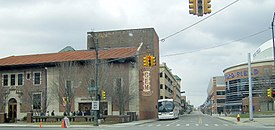| "Little Gem Theatre" | |
 Gem Theatre beside Ford Field. Gem Theatre beside Ford Field. | |
| Location | 333 Madison Street Detroit, Michigan |
|---|---|
| Coordinates | 42°20′15.63″N 83°2′46.22″W / 42.3376750°N 83.0461722°W / 42.3376750; -83.0461722 |
| Capacity | 450 |
| Opened | 1927 |
| Website | |
| Gem Theatre | |
| Century Building and Little Theatre | |
| U.S. National Register of Historic Places | |
| Coordinates | 42°20′15″N 83°2′47″W / 42.33750°N 83.04639°W / 42.33750; -83.04639 |
| Built | 1903 |
| Architect | George D. Mason |
| Architectural style | Renaissance |
| NRHP reference No. | 85000993 |
| Added to NRHP | May 09, 1985 |
The Gem Theatre is a performing arts theater located in Detroit, Michigan. Built in 1927 in the Spanish Revival style, it houses a two level theater with traditional row and aisle seating along with stage-level seating at cabaret tables. The Gem Theatre was listed on the National Register of Historic Places in 1985. It shares a lobby with the cabaret-style Century Theatre, built in 1903.
History
In 1902, the Twentieth Century Club, a group of cultural, socially prominent women, built a Mission-style building to house their club. The building, now the Century Theatre, is built of red brick trimmed with white sandstone. The first floor originally housed a dining room, while the second floor housed a 400-seat auditorium.
In 1928, the member of the Century club contracted George D. Mason to design a theater addition to the Century Club building. The resulting Spanish Revival-style building was leased to the Little Theatre chain, which showed foreign films, and the building was known as the Little Theatre.
In 1933, due to the Depression, the Twentieth Century Club disbanded. The Little Theatre, however, continued, suffering through several name changes, becoming The Rivoli in 1932, Drury Lane (and then the Europa) in 1935, the Cinema in 1936, and the Vanguard Playhouse in 1960. The Vanguard offered live theater rather than movies.
The theater received its present name in 1967. The building was used as an adult movie house until it closed in 1978. Soon afterward, developer Charles Forbes purchased the combined Gem/Century building, and began a complete restoration of the Gem Theatre in 1990. The refurbished Gem opened in 1991.
Protected from demolition during urban renewal for Comerica Park, the newest home of the Detroit Tigers, the Gem Theatre and Century Theatre were moved five blocks on wheels to its new location at 333 Madison Street on 16 October 1997. At a distance of 563 meters (1,850 feet) it is the furthest known relocation of a sizable building.
References
- ^ "National Register Information System". National Register of Historic Places. National Park Service. April 15, 2008.
- ^ History page Archived 2008-11-21 at the Wayback Machine from Gem Theatre
- Guinness World Records. "Farthest Building Relocation". Accessed 26 August 2006.
Further reading
- Hauser, Michael; Marianne Weldon (2006). Downtown Detroit's Movie Palaces (Images of America). Arcadia Publishing. ISBN 0-7385-4102-8.
- Hill, Eric J.; John Gallagher (2002). AIA Detroit: The American Institute of Architects Guide to Detroit Architecture. Wayne State University Press. ISBN 0-8143-3120-3.
- Meyer, Katherine Mattingly and Martin C.P. McElroy with Introduction by W. Hawkins Ferry, Hon A.I.A. (1980). Detroit Architecture A.I.A. Guide Revised Edition. Wayne State University Press. ISBN 0-8143-1651-4.
{{cite book}}: CS1 maint: multiple names: authors list (link) - Sharoff, Robert (2005). American City: Detroit Architecture. Wayne State University Press. ISBN 0-8143-3270-6.
External links
 | ||
- Theatres in Detroit
- Music venues in Michigan
- Relocated buildings and structures in Michigan
- Theatres on the National Register of Historic Places in Michigan
- Event venues established in 1927
- National Register of Historic Places in Detroit
- 1927 establishments in Michigan
- Spanish Revival architecture in Michigan


